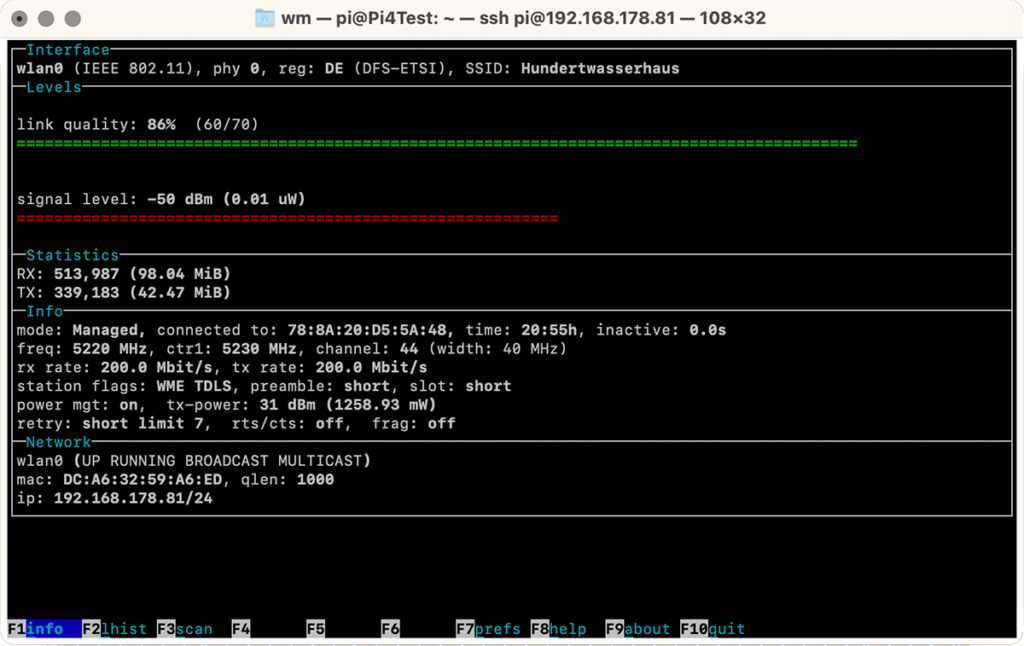Wireless device monitoring with wavemon
wavemon is a wireless device monitoring software that allows you to watch signal and noise levels, packet statistics, device configuration, and network parameters of your wireless network hardware. It was written by Jan Morgenstern and is regularly maintained.
It allows you to display your WiFi signal strength in realtime.
Installation and start
You install wavemon with
sudo apt install wavemon -y
And start it with
wavemon
and a dashboard appears.

If you can’t see the function keys at the bottom, you need to make your Terminal window larger.
What the information means
Let’s quickly run through the data points that you want to look at to understand better the WiFi quality that your digital picture frame enjoys.
Signal strength
Basically, the higher the signal strength, the more reliable the connection and higher speeds are possible. The signal strength is specified as -dBm (decibels related to one milliwatt).
Values between 0 and -100 are possible, with more being better. So -51 dBm is a better signal strength than -60 dBm.
However, the value 0 is not realistic. Even -30 dBm is hard to reach, and you have to stand almost directly next to the access point.
Here is some guidance on how to read the results:
- 50 dBm is considered an excellent signal strength.
- 67 dBm is said to be the minimum signal strength for reliable and relatively fast packet delivery.
- 70 dBm is the minimum signal strength for reliable packet delivery.
- The minimum value for a basic connection is -80 dBm. However, packet delivery is no longer necessarily reliable.
- 90 dBm is already very close to the basic noise. Here a connection probably does not work anymore.
Link quality
A network can be received with a very good signal strength but not so good link quality.
In simple terms, it means how much of the data you send and receive will make it to the destination in good condition.
The quality indicator includes data like Bit Error Rate (BER), i.e., the number of bit errors in received bits that have been altered due to noise, interference, distortion, or bit synchronization errors. Others are Signal-to-Noise and Distortion Ratio (SINAD).
It is measured in percentage or on a scale of up to 70. So you will see a value like “60/70”.
Unlike signal strength, it is somewhat harder to say which values are still considered to be ok.
But if the value is low and your signal strength is high, you may get interference from, e.g., kitchen appliances or other electronic devices. Moving them further away may improve the link quality.
Frequency
Another interesting indicator is the WiFi frequency.
This shows if your Raspberry Pi connects to the slower 2.4 GHz network, or the faster 5 GHz version, provided, of course, that your router offers both networks.
freq: 5220 MHz, ctr1: 5230 MHz, channel: 44 (width: 40 MHz)
Alternatives
An equally good tool to measure WiFi performance is
iwconfig
which gives you a snapshot of the Wifi quality as compared to the live data of wavemon.
wlan0 IEEE 802.11 ESSID:"Hundertwasserhaus"
Mode:Managed Frequency:5.22 GHz Access Point: 78:8A:20:D5:5A:48
Bit Rate=180 Mb/s Tx-Power=31 dBm
Retry short limit:7 RTS thr:off Fragment thr:off
Power Management:on
Link Quality=61/70 Signal level=-49 dBm
Rx invalid nwid:0 Rx invalid crypt:0 Rx invalid frag:0
Tx excessive retries:49 Invalid misc:0 Missed beacon:0
Tx excessive retries:49 Invalid misc:0 Missed beacon:0
Comments
Post a Comment